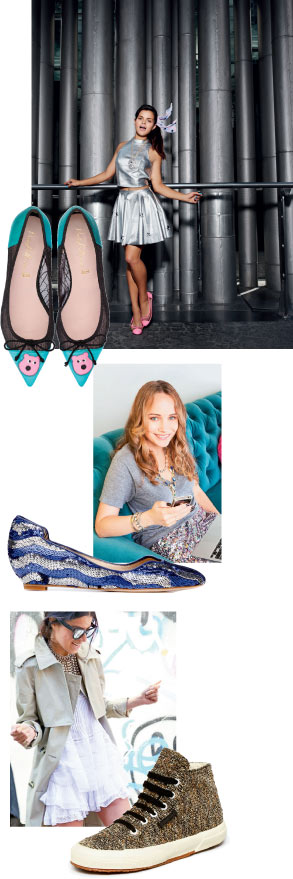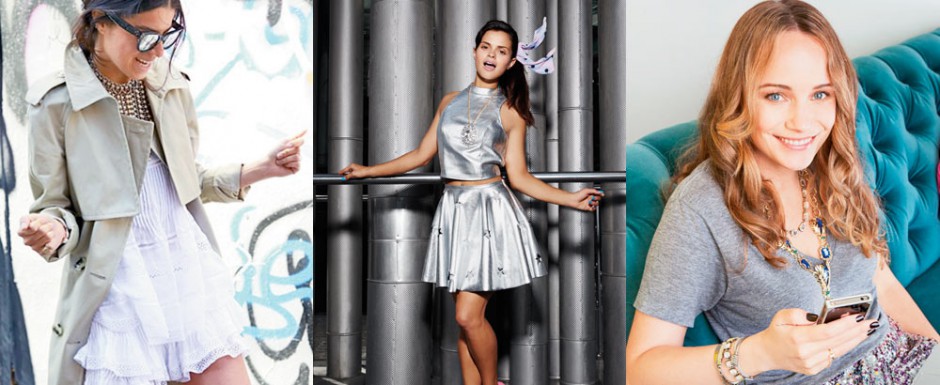
When Anna Wintour found herself sitting next to 14-year-old Style Rookie blogger Tavi Gevinson at a Band of Outsiders runway show during New York Fashion Week three years ago, not even the Vogue editor in chief’s signature shades could hide her disdain about the fashion world’s inner sanctum being invaded by a pint-sized interloper. Not that this was the first time Gevinson had been seated in the front row; no, the wunderkind had been sitting pretty at the likes of Christian Dior and Rodarte since she launched her blog at the age of 11. But it was the first time she had been seated next to the editrix and, one might say, bloggers had officially arrived.
Like Gevinson, leading fashion bloggers offer fresh insight and influential opinion, often generating instant feedback from their legions of followers. Fans respond to their advice on what to wear and what to buy, and these bloggers have the power to introduce new brands and accelerate burgeoning trends. For millions of consumers, particularly younger-aged ones, they are the personal stylists residing in their smartphones. “Bloggers serve a variety of purposes for consumers, but none more important than curation,” says Rachel Lewis, senior strategist at iProspect, a digital marketing agency whose clients include Cole Haan and Converse. “In the shoe space, the consumer is faced with endless choices. Readers look to bloggers to help make those buying decisions easier through recommendations or endorsements.” Zappos Assistant Buyer Angela Gonzalez echoes this sentiment. “Whether we follow bloggers because we like their style, advice on different aspects of life or find them relatable as people, they’re giving us more options on how to interpret and be inspired by fashion,” she says.
Lewis notes that bloggers serve retailers well, too, by delivering a highly engaged audience with a demonstrated interest in a particular category. That gives merchants the opportunity to win over consumers or re-engage existing ones. And with fashion bloggers’ uniquely deep engagement and influence, the ROI is much higher than, say, paying Kim Kardashian $10,000 for a tweet. Some of the better-known fashion blogs attract audiences in the hundreds of thousands per month and garner hundreds of comments per post. To put that in perspective, some personal style blogs have equal or, in some cases, bigger followings than many niche print fashion magazines. According to the Technorati Digital Influence Report 2013, a study that surveyed 6,000 influencers, 1,200 consumers and 150 top brand marketers, fashion bloggers are 31.1 percent likely to influence a purchase, ranking behind retail sites (56 percent) and brand sites (34 percent), and ahead of online magazines (20 percent).
It was only a matter of time before blogger-brand collaborations would arise. “Welcome to the new world of retail,” quips Marshal Cohen, chief industry analyst at the NPD Group. “It’s very simple: the younger generation lives and breathes by the Internet, and progressive brands are reaching out to bloggers and partnering with them in a way that can reach a much broader audience.”
It’s a way to market to potential customers in a more conversational way, too. As Matt Priest, president of the Footwear Distributors and Retailers of America, explains, “You have a built-in group of interested consumers who obviously follow certain bloggers and trust their opinions, value their insight and find them humorous and interesting. It creates a natural opportunity for footwear companies to partner with them and find a way to speak to those followers through shoes.”
Gonzalez calls these collaborations a fun and innovative way to add a new facet to an existing line. “It gives the customer a fresh, original appeal and gives the brand the opportunity to attract new consumers,” she says. Elena Brennan, owner of the Philadelphia-based boutique Bus Stop, who frequently invites her favorite local fashion bloggers to in-store events (their presence boosts sales) believes it’s “a natural progression” for bloggers to start designing shoes rather than simply donning gifted product for photo opps. Regina Smith Popp, DSW’s fashion trend manager, says blogger collabs bring a level of authenticity to the brand. “Once bloggers have established themselves as style mavens it makes sense to take that aesthetic and apply it to a brand and let their style DNA rub off to influence a collection,” she says.
To wit, Leandra Medine, the fashion force behind The Man Repeller, has successfully collaborated with Miami-based Del Toro on a flamingo-adorned smoking slipper and Superga on a capsule collection of velvet and bouclé sneakers that’s available at the likes of Kitson, Urban Outfitters and Bloomingdale’s. Steve Madden, meanwhile, has teamed with Italian fashion blogger Chiara Ferragni of The Blonde Salad on a tight collection of peep toe booties, Lucite sandals and single-sole stilettos that was picked up this spring by Nordstrom, Piperlime and Zappos. Madden looks to keep that momentum going in the fall with a new partnership with Peace Love Shea blogger, Shea Marie.
“It’s a grass roots play at the end of the day,” notes Priest. “It’s someone who’s one of us and who maybe can connect better with the average consumer than corporate marketing would.”
That’s the hope with Natalie Off Duty blogger Natalie Suarez’s involvement with New York label Modern Vice. As co-founder Jordan Adoni points out, Suarez epitomizes everything the line stands for: classic looks with a downtown edge. The collaboration even helped get the brand off the launch pad in Spring ’13. “It definitely helped get us into certain markets (like Oak and Wink in New York and American Rag in Los Angeles) that we thought would be a fit for Modern Vice,” Adoni says, adding that it also helped give Suarez, who has appeared in campaigns for Timberland, Ugg and Minnetonka, “a lot of credibility as a substantial designer and stylist.”
While David Bell, founder and creative director of Pretty Ballerinas, is no stranger to tapping into the blogosphere (Ella Catliff of La Petite Anglaise is the face of sister brand Pretty Loafer’s Fall ’14 campaign), he had never considered collaborating with a blogger on a design level—until he met the British social media sensation and DJ, Bip Ling. “She fits so well with the brand image. She’s little and cute, and our brand is small with a big personality,” Bell notes. The colorful six-piece collection, which hit stores in time for the holidays, featured her blog’s signature cartoon character, Mooch, and a truckload of glitter and jazzy trimmings. “The styles have sold well, which isn’t easy for such bright colors and pointed toes with a Mooch face on them,” Bell says. “These collaborations are fun, because they introduce our brand to new people who don’t know it but also introduce Bip to people who know us.” Similarly, New York-based shoe designer Matt Bernson recruited Grace Atwood of Stripes & Sequins to put her own spin on some of his eponymous brand’s bestselling styles after she tweeted her love for his Waverly flat. (Atwood has nearly 15,000 Twitter followers.) The six-piece offering launched this spring and sold out almost immediately on Shopbop and at Anthropologie stores nationwide. “We really wanted to make something that would appeal to her fans,” Bernson says, adding that he was “blown away” by the response and is considering extending the partnership. Atwood is equally pleased. “The business of blogging is always under scrutiny so it was refreshing to see that these worked,” she shares. “It was important to me that the shoes be something that my readers would pick up if they saw it in a store and feel like they had to buy it.” Bernson’s team kept this in mind when it came to retail placement. “We decided that the collection would fit best with Anthropologie and Shopbop as they’re both very blogger-friendly,” he says, adding that Atwood’s design influence enabled the brand to step beyond its normal aesthetic. “The fact that she likes to add glitter and sequins took us in a different direction, but in a way that was comfortable with our brand and our audience,” he notes.
The intimacy and immediacy of social media is a key factor behind the success of blogger-brand collaborations. “Fashion and footwear brands have discovered that the blogosphere creates a more natural environment to engage with relevant consumers,” says Lewis of iProspect, adding that followers are likely to have a strong connection to that blogger, which gives brands—and retailers—the opportunity to tap into that audience. That’s what Giorgio Brutini partly had in mind when it asked menswear blogger Adam Gallagher of IAmGalla.com to star in its Fall ’13 marketing campaign. Barry Specht, vice president of marketing of parent company Harbor Footwear Group, also planned for a capsule collection of dress-inspired looks but, unfortunately, the ad campaign (specifically the growing popularity of Gallagher) caught the attention of Ted Baker and Gucci. “We’re still talking to Adam, he still features our products on his blog, but the collaboration has moved to the backburner for both of us at this point,” Specht offers.
Indeed, not every brand-blogger partnership is a success. Some efforts generate little in the way of traffic, and hits alone do not necessarily translate into sales. Unlike celebrity endorsements that have enormous consumer reach, blogger collabs tend to be more limited in scope. “It isn’t for all segments of our market,” says Priest, adding that Millennials, who spend an average of seven hours a day online, are more likely to embrace these capsule collections. “There’s a whole side of consumers who don’t know who bloggers are.” Fraser Ross, founder of Kitson, says that while his stores carried The Man Repeller x Superga collection, he thinks it sold well because it was Superga, not the Man Repeller affiliation. “These collaborations are a flash in the pan,” he quips. However, Holly Pavlika, senior vice president of brand strategy at Collective Bias, a company that coordinates freelance bloggers to publish content for branded marketing campaigns, believes collaborations between brands and actual audiences are here for the long term. “Brands understand that marketing has been turned on its head and the consumer is king,” she says.
Gonzalez of Zappos points out that that such collaborations give the consumer an opportunity to obtain a limited design and an interpretation of a trend directly from that blogger. She also notes that she picked up The Blonde Salad x Steve Madden collection not only because it was “edgy and playful,” but because it represents how heavily the industry is influenced by social media. Love them or loathe them, it looks like brand-blogger collaborations have legs for now. “Given the current success and reach of bloggers, it’s a valuable channel to connect with the customer,” says Popp, who adds that DSW regularly engages bloggers for such promotions as #DSWShoeHookUp, which enlisted 50 bloggers to give away 250 pairs of shoes last December. “Based on the excitement and energy it drives to our stores and website, we’re really excited to continue to partner with bloggers who share our shoe love.”
Likewise, FDRA’s Priest believes anything that helps spark a sale is fine by him. “Driving grass roots interest amongst consumers using bloggers—who are really the voice of the consumer in many ways—is fantastic,” he says. Cohen of NPD agrees: “It’s no longer enough for retailers to just put the product out there and state the facts. It’s about romancing the product, helping consumers understand why they need to buy it. Blogger collaborations can help get that point across.”




